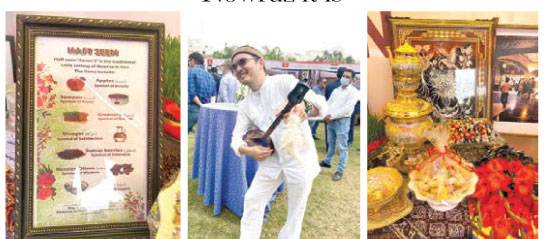Nowruz, an Iranian new year and also, the first day called ‘Farvardin’ in the Persian calendar has been celebrated by the Persian kings and royalties for centuries on spring equinox. The kings would sit on the royal throne, and the astronomer of the court would come forward, kiss the ground and congratulate the king on arrival of the new year. The celebrations would commence with music and dance followed by a lavish feast over many following days.
Nowruz managed to survive many history upheavals and change of rulers. Even Mongols and Turks continued to celebrate the tradition of Nowruz and as of today, after Iran, Afghanistan and Turkey, even Central Asian countries celebrates Nowruz and it’s a national holiday on the day of Nowruz. Taking due advantage of the century’s old tradition and under the umbrella of cultural diplomacy, the management of Serena Hotels under the steward leadership of its Chief Executive Officer of South and Central Asia, Mr. Aziz Boolani, organised a big fiesta in the lawn of the hotel. Tents were pegged by the Nowruz participating countries in the likes of Turkey, Iran, Kazakhstan, Tajikistan, Afghanistan and other central Asian states with food, pottery, artwork and clothing’s on display.
The host participants were wearing mostly traditional costumes, showcasing their traditional attire whereas the ambassadors were diplomatically dressed in suits and tie.
Standing near the stall with fellow Iranian diplomats, Mohammad Sorkhabi, the deputy head of mission, elaborated on the concept of “seven Ss” in Nowruz. The basic concept of this tradition is rejuvenation, celebration and abundance, serious spring house-cleanings and even more serious table spread, where all the food items are arranged to make what we call a ‘Haft Seen’ which in English translates as seven Ss, he said smilingly. The whole festivity revolves around it which start with Sabzeh, something green which represents rebirth or rejuvenation; Samanu, a sweet wheatgrass pudding symbolising wealth and affluence; Senjed symbolises love and it’s a shrub; Seer is garlic and is related to life medicine; Sib, apple, is sign of a healthy life and beauty; Somaq, sour red berries commonly used in Persian cuisine; and Serkeh, vinegar, symbolises maturity and we start with Sabzi Pulao, a herbed rice served with fish and garnished with almonds, pistachio and walnuts, a Nowruz mainstay, the deputy head of mission explained.
The Turkish stall had a beeline as many diplomats and local attendees were craving to savour the Turkish delights. The coffee was being served fresh whereas the Turkish sweets in the form of pastries cooked with fruits, milk, coconut, powdered bites, baklava’s, Turkish churros etc., along bejewelled coffee/tea cups, saucer sets, Turkish evil eye (nazar) ornaments in the likes of wall hangings and jewellery etc. A senior diplomat from the Embassy of Kazakhstan, Arman Tynybek was mesmerising the guests, dressed in all white clothing with an embroidered traditional hat representing one of the regions of his country and roaming freely with a Dombra, a form of guitar in his hand. He seemed rather professional music lover as his fingers were moving flawlessly with the strings.
Serena’s manicured gardens were in full bloom too with flowers sprouting and it seems that Nowruz is very much a celebration in Islamabad as well. A big canopy was set up for the formal ceremony and the itinerary included welcome address by the host, Mr. Boolani, an introductory speech by the Dean of Diplomatic Corps, Ambassador of Turkmenistan H.E. Atadjan Movlamov, followed by cultural performances from the participating countries.
–The writer is a freelance
contributor
Wednesday, November 20, 2024
Nowruz it is

Tribal elder among four killed in Bannu firing
November 20, 2024
Fazl always puts interests of Pakistan first: Naqvi
November 20, 2024
ATC issues non-bailable arrest warrants for KP CM Gandapur
November 20, 2024
CM Maryam launches country’s first dialysis card programme
November 20, 2024
ADB approves $500m to tackle climate change impacts
November 20, 2024
-
Hunger crisis to increase in South Sudan, warns UN
-
Hunger crisis to increase in South Sudan, warns UN
-
Pakistan’s judiciary champions climate justice at COP29 in Baku
-
Punjab struggles with persistent smog as Met Office forecast rainfall
-
Punjab residents face escalating smog crisis as pollution levels soar across country
-
Qatar says Hamas 'no longer welcome' in Gulf state
Digital Stagnation
November 20, 2024
Xi’s Red Lines
November 20, 2024
Last Call
November 20, 2024
Sindh & Indus
November 19, 2024
Another US Escalation
November 19, 2024
Tackle Corruption Within School Boards
November 20, 2024
To Be Opportunistic
November 20, 2024
Democratic Backsliding
November 20, 2024
Empowering Tharparkar through Skills Development
November 20, 2024
Why Not Use AI to Address Climate Change?
November 19, 2024
ePaper - Nawaiwaqt
Nawaiwaqt Group | Copyright © 2024





